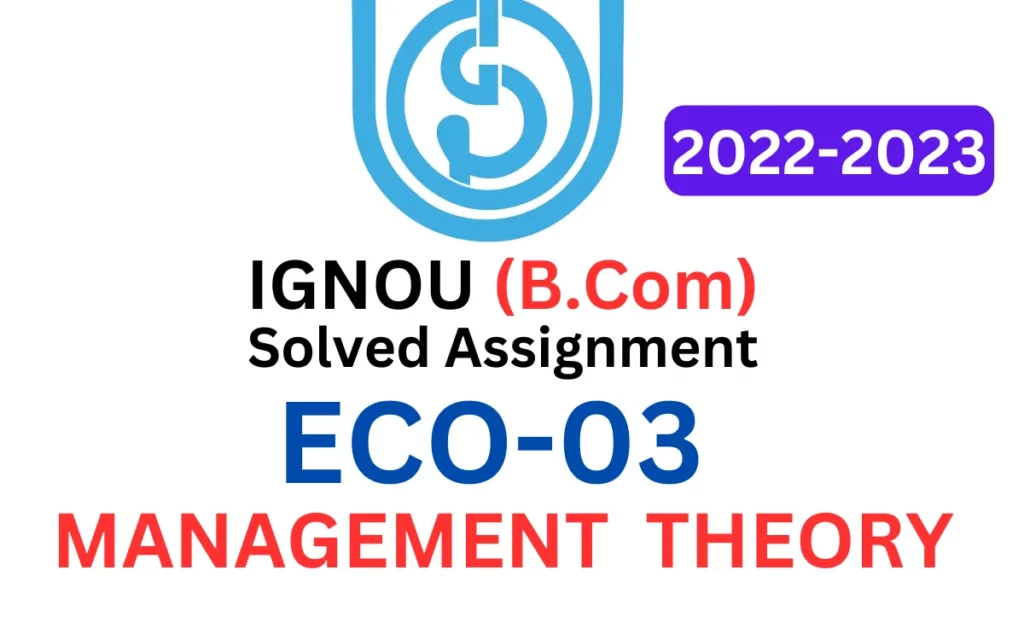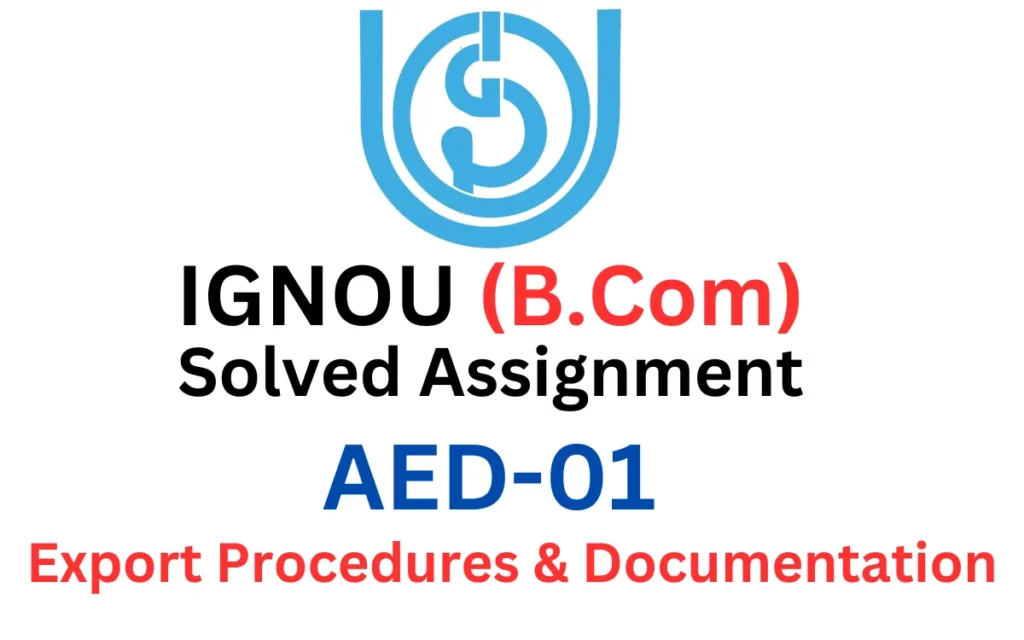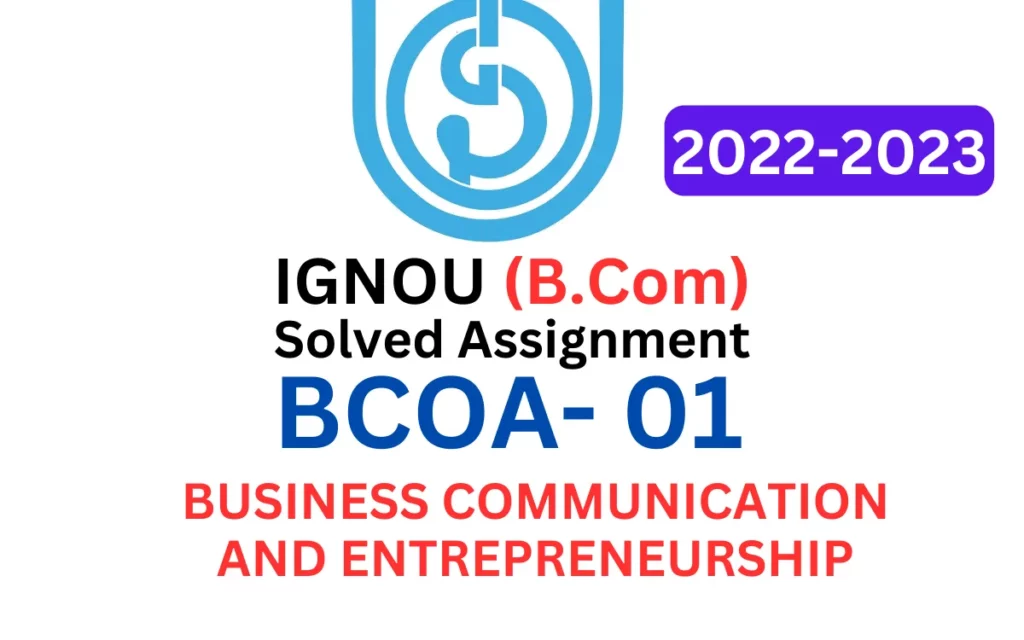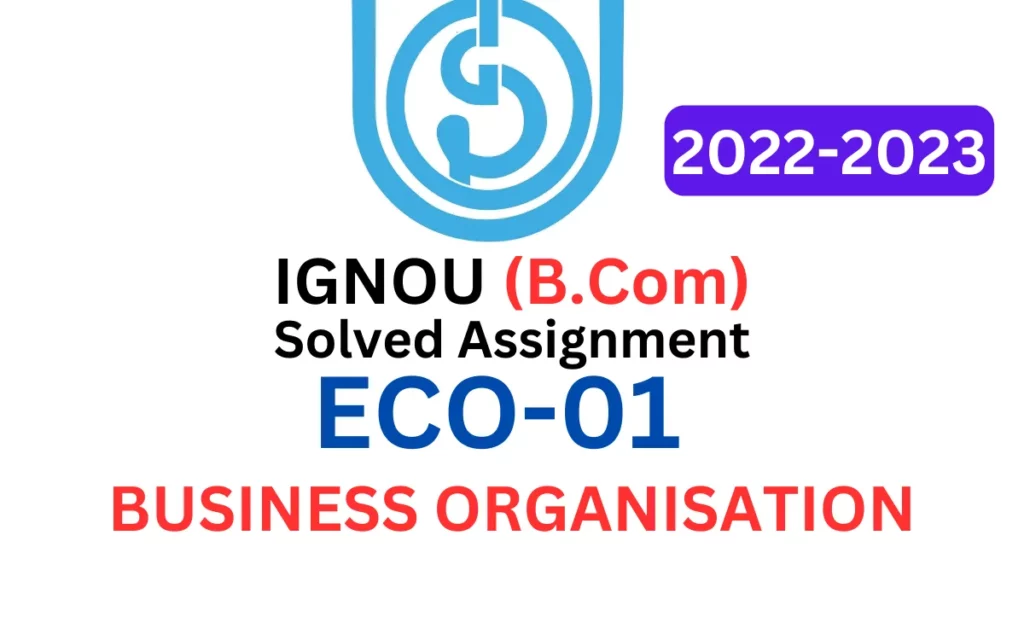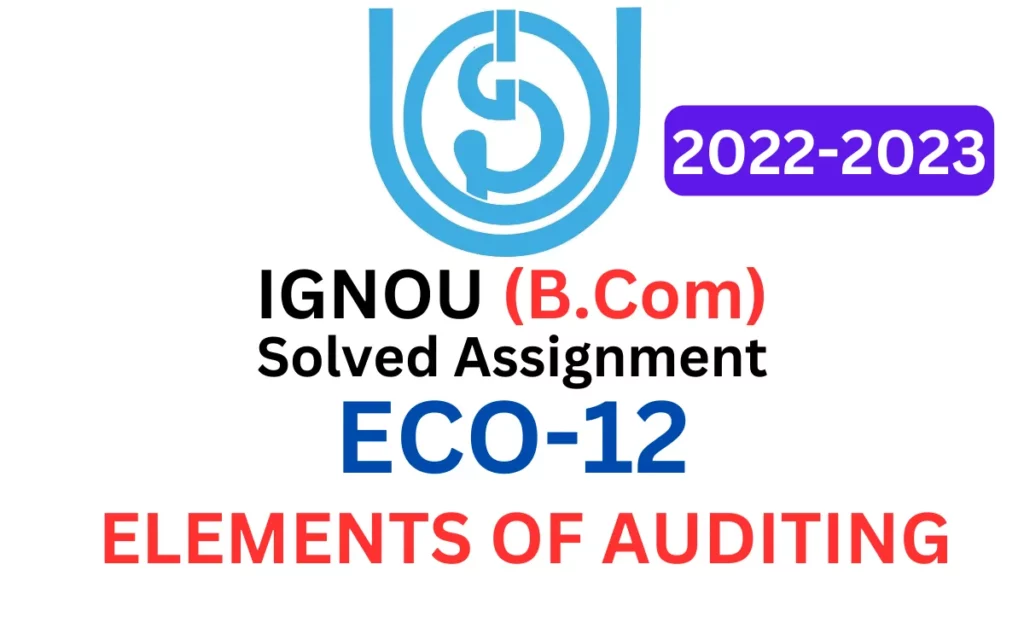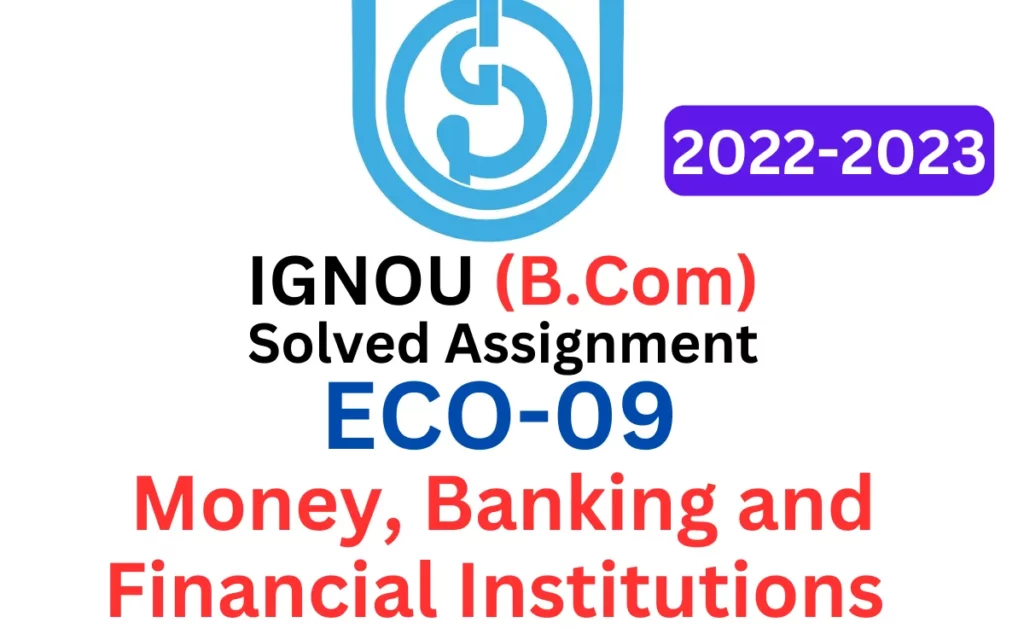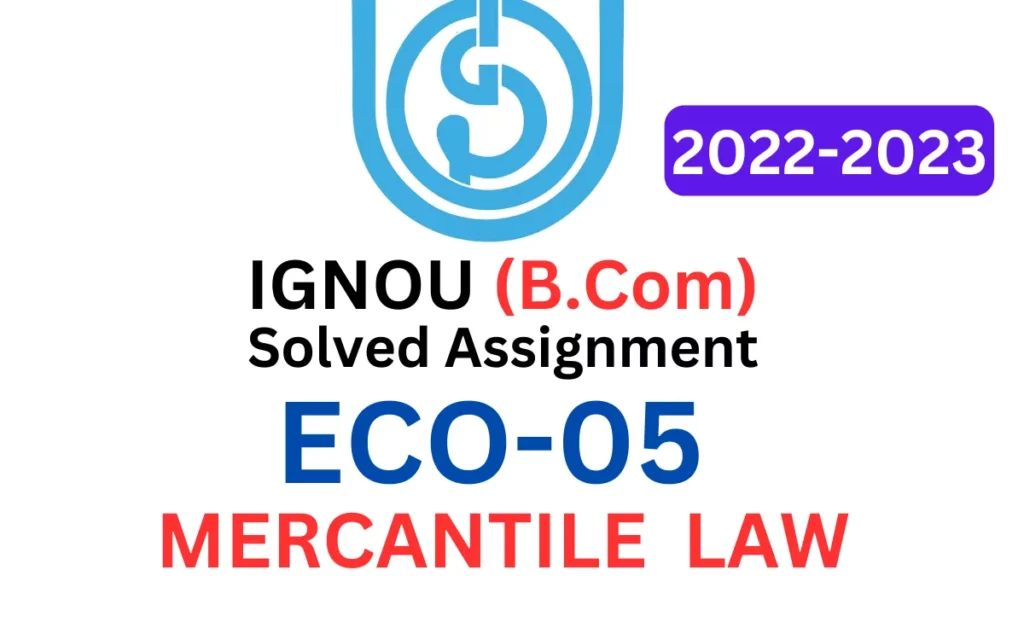Contents
- 1 1. Differentiate between centralised and decentralised systems of purchasing stationery. Compare their relative merits and demerits. Which method will you adopt for a big organisation whose branches are located in different cities?
- 2 2. (a) Do you mean by office management? What are the elements of office management?
- 3 (b) Explain the significance of internal office communication. Mention the types of inter-communication found in a modem office.
- 4 3. Briefly comment on the following:
- 5 (a) “The sanitary conditions prevailing in the office have a potent effect on the staff and consequently on the quality and volume of work accomplished.”
- 6 (b) “Indexing is an integral part of filing and records management.”
- 7 (c) “One of the common faults of office management is unwanted mechanisation.”
- 8 (d) “Handling of information is the basic component in the office management process today”.
- 9 4. Write short notes on the following:
- 10 (a) Leasehold building for office accommodation
- 11 (b) Essentials of a good filing system
- 12 (c) Time and motion study for setting standards
- 13 (d) Features of supervision
- 14 5. Distinguish between the following:
- 15 (a) Employee Manual and Procedure Manual
- 16 (b) Financial Data and Non-financial Data
- 17 (c) Medical benefits and Recreational benefits for staff welfare
- 18 (d) Centralised and Decentralised correspondence
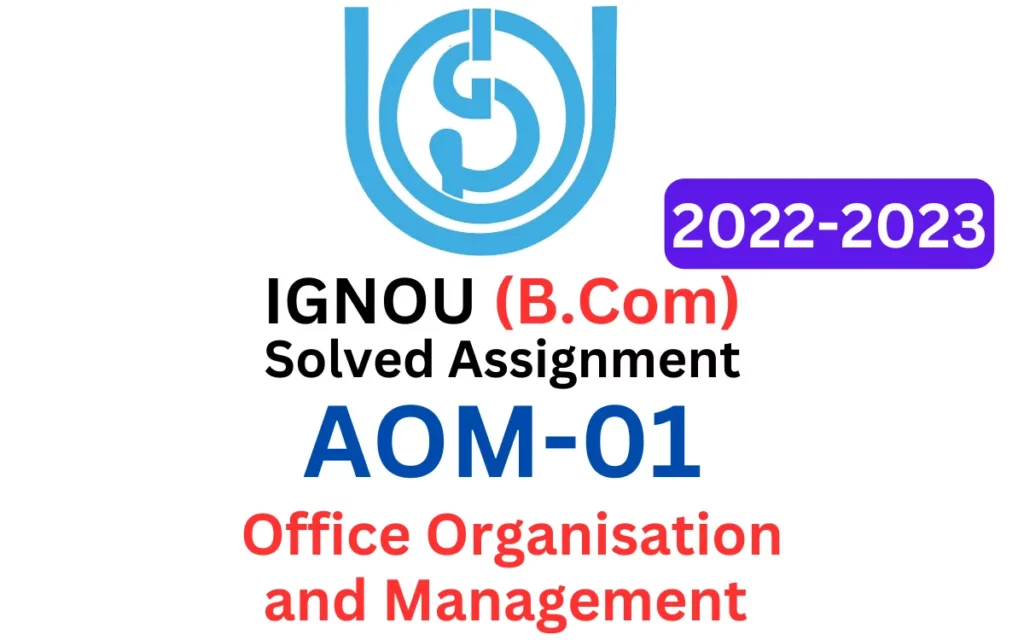
| Title | AOM-01: IGNOU B.Com Solved Assignment 2022-2023 |
| University | IGNOU |
| Degree | Bachelor Degree Programme |
| Course Code | AOM-01 |
| Course Name | Office Organisation and Management |
| Programme Name | B.Com |
| Programme Code | BDP |
| Total Marks | 100 |
| Year | 2022-2023 |
| Language | English |
| Assignment Code | AOM – 01/TMA/2022-2023 |
| Assignment PDF | Click Here |
| Last Date for Submission of Assignment: | For June Examination: 31st April For December Examination: 30th September |
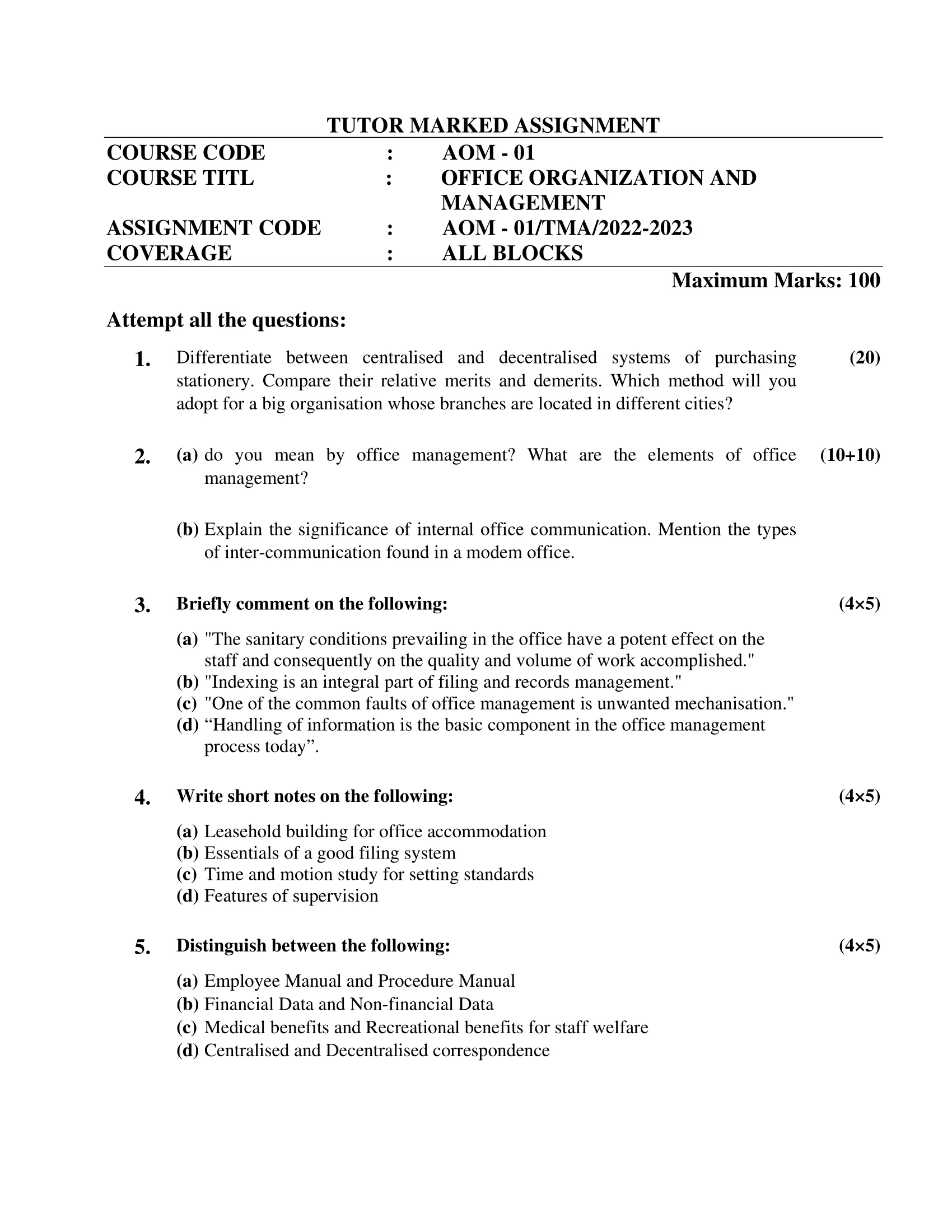
1. Differentiate between centralised and decentralised systems of purchasing stationery. Compare their relative merits and demerits. Which method will you adopt for a big organisation whose branches are located in different cities?
Ans: Centralized and Decentralized systems of purchasing stationery are two approaches to manage the process of purchasing office supplies for an organization.
Centralized System of Purchasing Stationery:
In a centralized system, the purchasing process is controlled by a single department or individual in the organization, usually located in the head office or central location. The central purchasing department is responsible for purchasing stationery supplies for all the branches of the organization.
Merits:
- Centralized purchasing allows for better coordination and control over the entire procurement process, resulting in reduced costs and increased efficiency.
- Bulk purchasing enables the organization to negotiate better prices, leading to cost savings.
- With a centralized purchasing system, there is greater consistency in the type and quality of stationery supplies purchased.
Demerits:
- In a centralized system, the head office may be far away from some branches, which may lead to delays in the delivery of stationery supplies.
- The centralized department may not have the necessary knowledge of the needs of all the branches.
- There is the possibility of the central department being overloaded with work, leading to delays in the procurement process.
Decentralized System of Purchasing Stationery:
In a decentralized system, the purchasing of stationery supplies is done by individual departments or branches of the organization. Each branch is responsible for purchasing its stationery supplies, and there is no centralized control over the procurement process.
Merits:
- In a decentralized system, individual departments have more control over the stationery supplies they require.
- The decentralized system is more flexible, and the branches can purchase the stationery supplies they need without waiting for approval from the central department.
- The branches have better knowledge of their specific stationery requirements, leading to better decisions in purchasing supplies.
Demerits:
- Decentralized purchasing can result in a lack of consistency in the type and quality of stationery supplies purchased.
- The organization may not benefit from bulk purchasing, leading to higher costs.
- The decentralized system can lead to inefficiencies and duplication of work.
For a large organization with branches located in different cities, a centralized system of purchasing stationery would be more appropriate. The centralized system would provide better coordination and control over the procurement process, leading to cost savings and increased efficiency. However, the central department must work closely with the branches to understand their needs to avoid delays in the delivery of stationery supplies.
2. (a) Do you mean by office management? What are the elements of office management?
Ans: Office management refers to the process of organizing and coordinating office operations and procedures to ensure efficiency, productivity, and effectiveness in achieving the objectives of the organization.
The elements of office management are:
- Planning: The process of determining the objectives of the organization and setting goals to achieve them. It involves the development of policies, procedures, and strategies to guide office operations.
- Organizing: The process of arranging resources, including people, equipment, and materials, to achieve the objectives of the organization. It involves the creation of structures and systems to ensure efficient operations.
- Staffing: The process of hiring, training, and managing personnel to perform the tasks required to achieve the objectives of the organization. It includes job analysis, recruitment, selection, and training of staff.
- Directing: The process of guiding, motivating, and supervising employees to perform their tasks effectively. It involves setting goals, providing feedback, and ensuring that the employees understand their roles and responsibilities.
- Controlling: The process of monitoring and evaluating office operations to ensure that they are on track and within budget. It involves setting performance standards, measuring progress, and taking corrective action when necessary.
- Communication: The process of exchanging information within and outside the office. It involves the use of various communication channels, including oral, written, and electronic, to ensure effective communication.
- Record-Keeping: The process of maintaining accurate and up-to-date records of office operations, including financial records, personnel records, and operational records.
Effective office management requires a combination of these elements to ensure efficient and effective operations.
(b) Explain the significance of internal office communication. Mention the types of inter-communication found in a modem office.
Ans: Internal office communication is essential for the smooth functioning of an organization. Effective communication within the office ensures that information is exchanged accurately and timely, leading to improved decision-making, increased productivity, and better coordination among employees.
The significance of internal office communication are:
- Increased Efficiency: Effective communication within the office ensures that information is exchanged in a timely and accurate manner, leading to improved decision-making, and increased efficiency.
- Better Coordination: Communication within the office helps in better coordination between different departments, teams, and individuals, leading to improved teamwork, and greater productivity.
- Improved Work Culture: Effective communication within the office creates a positive work culture, leading to better relationships between employees, and a more conducive working environment.
- Improved Employee Morale: Regular communication with employees helps in keeping them informed about the organization’s goals and objectives, leading to improved morale and job satisfaction.
- Increased Innovation: Internal communication within the office fosters a culture of innovation, leading to better problem-solving, improved creativity, and increased innovation.
Types of inter-communication found in a modern office are:
- Verbal Communication: Communication that occurs through speaking, including face-to-face conversations, meetings, and telephone calls.
- Written Communication: Communication that occurs through writing, including email, memos, reports, and letters.
- Electronic Communication: Communication that occurs through electronic means, including social media, instant messaging, and video conferencing.
- Non-Verbal Communication: Communication that occurs through body language, including gestures, facial expressions, and tone of voice.
- Visual Communication: Communication that occurs through visual means, including graphs, charts, and presentations.
Effective communication within the office requires a combination of these types of communication to ensure that information is exchanged accurately and timely.
3. Briefly comment on the following:
(a) “The sanitary conditions prevailing in the office have a potent effect on the staff and consequently on the quality and volume of work accomplished.”
Ans: This statement highlights the importance of maintaining clean and healthy workspaces in offices. Poor sanitary conditions can have negative effects on the health and well-being of employees, which can in turn impact their productivity and performance. Ensuring a clean and hygienic work environment can help to create a more pleasant and productive workplace. Employers have a responsibility to provide a safe and healthy work environment for their employees, and maintaining good sanitary conditions is a key aspect of fulfilling that responsibility.
(b) “Indexing is an integral part of filing and records management.”
Ans: This statement emphasizes the importance of indexing in effective filing and records management. Indexing refers to the process of creating an organized list of keywords, terms, or topics associated with a particular document or record, which can help to make it easier to locate and retrieve the information in the future. By creating an accurate and comprehensive index, organizations can improve their ability to manage their records and respond to requests for information.
Effective indexing is essential for ensuring that records are organized and easily accessible, which is important for maintaining efficient business operations and complying with legal and regulatory requirements. Without proper indexing, records may be difficult to find, which can lead to delays and errors in decision-making processes. As such, indexing is an integral part of effective records management and is essential for ensuring that businesses and organizations can operate effectively and efficiently.
(c) “One of the common faults of office management is unwanted mechanisation.”
Ans: This statement suggests that there is a risk associated with the overuse or inappropriate use of technology in office management. While technology can be a powerful tool for improving efficiency and productivity in the workplace, it is important to ensure that it is used in a way that is appropriate for the particular needs and circumstances of the organization.
Unwanted mechanization may refer to situations where technology is used unnecessarily, or where it is used in a way that is not aligned with the goals or values of the organization. This can lead to a number of problems, such as reduced employee satisfaction, decreased job security, and increased costs.
Effective office management involves finding the right balance between using technology to support business operations and maintaining a human-centric approach to work. By taking a thoughtful and strategic approach to the use of technology, organizations can improve their operations without sacrificing the needs and well-being of their employees.
(d) “Handling of information is the basic component in the office management process today”.
Ans: This statement emphasizes the critical role that information handling plays in modern office management. In today’s digital age, information is generated and exchanged at an unprecedented rate, and effective management of that information is essential for business success.
Effective information handling involves a number of key activities, including data collection, organization, storage, analysis, and dissemination. These activities are essential for ensuring that employees have access to the information they need to perform their jobs effectively, that business decisions are based on accurate and relevant data, and that regulatory and legal requirements are met.
In addition to the traditional paper-based records, modern office management also involves handling electronic records, emails, and other digital documents. Effective management of electronic records and information is becoming increasingly important due to the exponential growth of digital information.
4. Write short notes on the following:
(a) Leasehold building for office accommodation
Ans: A leasehold building for office accommodation is a type of real estate property that is leased to tenants for the purpose of using it as office space. The lease agreement typically grants the tenant the right to occupy the building for a specified period of time, subject to certain terms and conditions. In most cases, the tenant is responsible for paying rent and for maintaining the property in good condition during the lease term.
Leasehold buildings for office accommodation are a popular option for many businesses because they offer flexibility and convenience. Leasing allows businesses to avoid the significant upfront costs associated with purchasing a building, and it also provides the option to relocate to a different space at the end of the lease term. Additionally, many lease agreements include provisions for the landlord to maintain the building and make necessary repairs, which can reduce the burden on the tenant.
However, there are also some potential drawbacks to leasing office space. For example, lease agreements may include restrictions on the use of the space or may require the tenant to vacate the premises at the end of the lease term. Additionally, rent payments may increase over time, making it difficult for businesses to budget for long-term occupancy costs. Overall, the decision to lease a building for office accommodation depends on a variety of factors, including the business’s budget, growth plans, and long-term needs.
(b) Essentials of a good filing system
Ans: A good filing system is an essential component of effective office management. A well-organized filing system helps to ensure that important documents are easy to find and access, and it can help to streamline business operations and reduce the risk of errors or oversights. The following are some of the key essentials of a good filing system:
- Clear organization: A good filing system should be organized in a clear and consistent manner. This might involve categorizing documents according to type, date, or subject matter, and using clear and consistent labels to identify each category.
- Easy access: A good filing system should be designed to make it easy for users to find and access the documents they need. This might involve grouping related documents together, organizing them in a logical order, or providing an index or guide to help users navigate the system.
- Security: A good filing system should be designed to ensure the security of confidential or sensitive documents. This might involve using locks or other security measures to protect physical files, or using encryption or other digital security measures to protect electronic files.
- Regular maintenance: A good filing system should be regularly maintained to ensure that it remains organized and up-to-date. This might involve periodically reviewing and purging old or outdated files, or updating file labels or indexes to reflect changes in the business.
- Flexibility: A good filing system should be designed to be flexible and adaptable to changing business needs. This might involve using a modular or customizable system that can be easily reconfigured as needed, or using a digital system that can be easily updated and modified.
(c) Time and motion study for setting standards
Ans: A time and motion study is a technique used to analyze and optimize the workflow and processes involved in a particular task or activity. The goal of a time and motion study is to identify the most efficient and effective way to perform a task, by breaking it down into its component steps and analyzing the time and effort required for each step.
In the context of setting standards, a time and motion study can be used to establish benchmarks for the time and effort required to complete a particular task. By analyzing the workflow and identifying areas where improvements can be made, businesses can establish standardized procedures and expectations for how long it should take to complete a particular task or activity.
The process of conducting a time and motion study typically involves the following steps:
- Define the task or activity to be studied: This might involve observing workers in action, reviewing process documentation, or talking to stakeholders to understand the key steps and requirements involved in the task.
- Break the task down into its component steps: This involves identifying the discrete steps involved in completing the task, and noting the time and effort required for each step.
- Observe the task being performed: This might involve conducting a time and motion study in real-time, using video recordings or other monitoring tools to track the time and effort required for each step.
- Analyze the results: Once the time and motion data has been collected, it can be analyzed to identify areas where improvements can be made. This might involve identifying bottlenecks or inefficiencies in the workflow, or looking for opportunities to streamline or automate certain steps.
- Develop standards and best practices: Based on the results of the time and motion study, businesses can develop standardized procedures and best practices for completing the task. This might involve establishing performance metrics or benchmarks for how long it should take to complete the task, or developing training materials or job aids to support workers in following the established procedures.
(d) Features of supervision
Ans: Supervision is the process of overseeing and managing the work of others, in order to ensure that work is completed efficiently and effectively. The following are some of the key features of supervision:
- Direction: One of the primary features of supervision is providing direction and guidance to workers. This might involve setting goals and objectives, defining performance expectations, and outlining clear roles and responsibilities.
- Support: Supervision also involves providing support to workers, whether it be through training, coaching, or mentorship. Supervisors are responsible for helping workers build their skills and knowledge, and for providing resources and assistance to help them succeed.
- Evaluation: Supervision involves evaluating the performance of workers, in order to identify areas for improvement and provide feedback on their work. This might involve conducting performance reviews, providing regular feedback and guidance, and setting goals for improvement.
- Communication: Effective supervision requires strong communication skills, in order to build relationships with workers and foster a positive work environment. Supervisors must be able to communicate clearly and effectively, both verbally and in writing, in order to ensure that workers understand their expectations and can provide feedback on their work.
- Problem-solving: Supervisors must be able to identify and address problems that arise in the workplace, whether they be related to workflow, employee performance, or other issues. This might involve working with employees to find solutions to problems, or making changes to processes or procedures to improve efficiency.
5. Distinguish between the following:
(a) Employee Manual and Procedure Manual
Ans: Employee Manual and Procedure Manual are two different documents that serve different purposes in an organization.
- Employee Manual: An Employee Manual, also known as an Employee Handbook, is a document that outlines the policies, procedures, and guidelines that employees are expected to follow in an organization. It provides information about the organization’s culture, values, and expectations from employees. It also contains information about employee benefits, compensation, and performance management.
- Procedure Manual: A Procedure Manual, also known as an Operations Manual, is a document that outlines the step-by-step procedures and instructions for performing tasks or completing processes in an organization. It provides information about how tasks should be performed, who is responsible for performing them, and the expected outcomes. It also helps ensure consistency and standardization in the organization’s operations.
The main differences between an Employee Manual and Procedure Manual are:
- Purpose: The purpose of an Employee Manual is to provide employees with an overview of the organization’s policies, procedures, and guidelines. The purpose of a Procedure Manual is to provide detailed instructions on how to perform specific tasks or processes.
- Content: An Employee Manual typically includes information about the organization’s culture, values, and expectations from employees, as well as information about employee benefits, compensation, and performance management. A Procedure Manual typically includes detailed procedures and instructions for performing specific tasks or processes.
- Audience: An Employee Manual is intended for all employees in an organization, while a Procedure Manual is typically intended for employees who are responsible for performing specific tasks or processes.
(b) Financial Data and Non-financial Data
Ans: Financial data and non-financial data are two different types of information that organizations use to make decisions and assess their performance.
- Financial Data: Financial data refers to numerical information that relates to an organization’s financial performance, including revenues, expenses, profits, and losses. It includes data such as income statements, balance sheets, cash flow statements, and other financial reports. Financial data is used to assess an organization’s financial health and make decisions related to budgeting, investing, and financing.
- Non-financial Data: Non-financial data refers to information that is not directly related to an organization’s financial performance, but still plays an important role in decision-making. It includes data such as customer satisfaction surveys, employee engagement surveys, market research, and environmental impact reports. Non-financial data is used to assess an organization’s overall performance and make decisions related to areas such as marketing, human resources, and sustainability.
The main differences between financial data and non-financial data are:
- Nature of Information: Financial data provides numerical information related to an organization’s financial performance, while non-financial data provides qualitative information related to other aspects of an organization’s performance.
- Purpose: Financial data is primarily used for financial analysis and decision-making, while non-financial data is used to assess an organization’s overall performance and make decisions related to areas such as marketing, human resources, and sustainability.
- Metrics: Financial data is typically measured in financial metrics such as revenue, profit margin, and return on investment, while non-financial data is measured in non-financial metrics such as customer satisfaction, employee engagement, and environmental impact.
(c) Medical benefits and Recreational benefits for staff welfare
Ans: Medical benefits and recreational benefits are two different types of staff welfare benefits that organizations can offer to their employees.
- Medical benefits: Medical benefits are benefits provided to employees to support their health and well-being. They typically include health insurance, dental and vision insurance, disability insurance, and life insurance. These benefits help employees manage their healthcare costs, protect their income in case of illness or injury, and provide financial support to their families in case of death.
- Recreational benefits: Recreational benefits are benefits provided to employees to support their social and recreational needs. They typically include gym memberships, sports facilities, company outings and events, and other leisure activities. These benefits help employees manage their stress levels, improve their work-life balance, and build relationships with their colleagues.
The main differences between medical benefits and recreational benefits are:
- Purpose: Medical benefits are designed to support employees’ health and well-being, while recreational benefits are designed to support employees’ social and recreational needs.
- Cost: Medical benefits are typically more expensive for organizations to provide than recreational benefits, as they require significant investment in healthcare insurance and other medical support services.
- Impact: Medical benefits have a direct impact on employees’ physical and financial well-being, while recreational benefits have a direct impact on employees’ social and emotional well-being.
(d) Centralised and Decentralised correspondence
Ans: Centralized and decentralized correspondence are two different approaches to managing communication within an organization.
- Centralized correspondence: In centralized correspondence, all communication is managed by a single central department, typically the administrative or executive office. This department is responsible for drafting, sending, and receiving all communication on behalf of the organization. Centralized correspondence ensures consistency and quality control in communication, as all outgoing messages are reviewed and approved by a central authority.
- Decentralized correspondence: In decentralized correspondence, communication is managed by different departments or individuals throughout the organization. Each department or individual is responsible for drafting, sending, and receiving their own communication, without direct oversight or control from a central authority. Decentralized correspondence allows for greater flexibility and responsiveness in communication, as individuals can communicate more quickly and efficiently without having to wait for approval from a central authority.
The main differences between centralized and decentralized correspondence are:
- Control: Centralized correspondence provides more control over communication, as all messages are reviewed and approved by a central authority. Decentralized correspondence provides less control, as individuals have more autonomy to communicate as they see fit.
- Consistency: Centralized correspondence ensures greater consistency in communication, as all messages are reviewed and approved by a central authority. Decentralized correspondence may result in less consistency, as different individuals may communicate in different styles or with different levels of professionalism.
- Efficiency: Decentralized correspondence may be more efficient, as individuals can communicate more quickly and efficiently without having to wait for approval from a central authority. Centralized correspondence may be less efficient, as all messages must go through a central department, which may cause delays or inefficiencies.
How to Download AOM-01 Solved Assignment?
You can download it from the www.edukar.in, they have a big database for all the IGNOU solved assignments.
Is the AOM-01 Solved Assignment Free?
Yes this is absolutely free to download the solved assignment from www.edukar.in
What is the last submission date for AOM-01 Solved Assignment?
For June Examination: 31st April, For December Examination: 30th October

